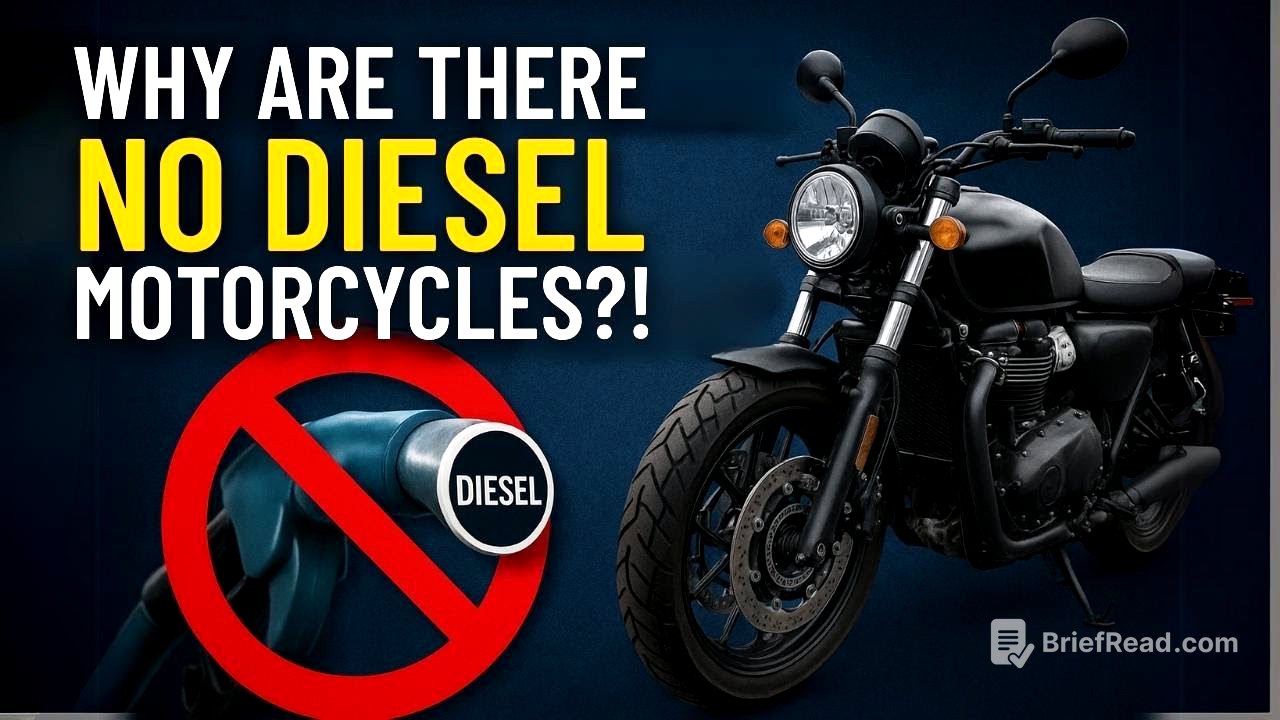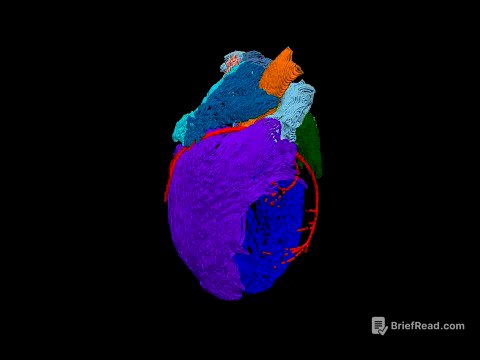TLDR;
This video explores why diesel motorcycles have never achieved widespread popularity despite the diesel engine's advantages in other applications. It examines the technical challenges, environmental concerns, practical constraints, and market forces that have hindered the success of diesel motorcycles, concluding that they simply cannot provide the performance and driving experience that motorcyclists desire.
- Diesel engines are heavier and larger than gasoline engines, which is a significant disadvantage for motorcycles.
- Diesel combustion is less controllable and more prolonged than gasoline combustion, resulting in vibrations and lower engine speeds.
- Diesel motorcycles struggle to meet modern emission standards without adding significant weight.
- The performance of diesel engines does not align with what motorcyclists seek: power, acceleration, and dynamic handling.
The Elusive Diesel Motorcycle [0:00]
The video introduces the concept of diesel motorcycles, highlighting their rarity in the market despite the widespread availability of motorcycles with gasoline engines and the emergence of electric motors. The video aims to explore the reasons behind the limited success of diesel motorcycles.
The Rise of the Diesel Engine [1:10]
The video explains the fundamental principle of the diesel engine, which relies on the compression of air to generate heat for fuel ignition, differentiating it from gasoline engines that use spark plugs. The development of the diesel engine was driven by the pursuit of economy and efficiency, tracing back to the thermodynamic cycle concept formulated by Nicola Leonard Sadi Carnot. Rudolph Diesel's work led to the creation of a practical diesel engine, which gained popularity due to its higher efficiency, fuel economy, and torque characteristics. Diesel engines are commonly used in various applications, including ships, tractors, trucks, and light vehicles, but are rare in aviation and motorcycle construction.
Diesel Motorcycles: A Rare Breed [3:03]
The video emphasizes the rarity of diesel motorcycles, noting that while some homemade models and small-series productions exist, major motorcycle brands have largely avoided them. Examples of manufacturers that produced diesel motorcycles in small quantities include Haze Diversified Technologies, Tundra Track, Neander, and Royal Enfield. Despite their efforts, none of these brands managed to capture a significant market share, leading to the cessation of production. The video dismisses conspiracy theories suggesting that the lack of diesel motorcycles is due to external forces, proposing that the reasons are more technical and practical.
Technical Challenges of Diesel Engines [4:50]
The video discusses the technical challenges associated with diesel engines, particularly in the context of motorcycles. Diesel engines require a high compression ratio (14:1 to 26:1) compared to gasoline engines (up to 14:1), resulting in a larger piston stroke and increased torque at low speeds. While this can be advantageous, it also leads to heavier and larger engine components to withstand the higher pressures. The increased weight and size are significant drawbacks for motorcycles, where compactness and lightness are crucial.
Limitations of Diesel Combustion [7:11]
The video explains that diesel combustion is less controllable and more prolonged compared to gasoline combustion. In diesel engines, ignition occurs at multiple hot spots due to the uneven temperature distribution in the combustion chamber, leading to vibrations and a characteristic sound. The crankshaft is often made heavier to mitigate these vibrations, further increasing the engine's weight. Additionally, diesel engines cannot achieve high speeds due to their long stroke and large connecting rods and pistons, which are prone to failure at high revolutions per minute. The video references the trinkler cycle, which modern diesel engines follow, emphasizing the need for sufficient time for complete fuel combustion.
The Environmental Impact on Diesel Motorcycles [9:50]
The video addresses the environmental impact of diesel engines and the challenges of meeting emission standards. To comply with regulations like Euro5, diesel engines require additional equipment, which increases their weight. The Royal Enfield Taurus, a relatively successful diesel motorcycle, was discontinued due to tightening environmental standards in India.
Practical Constraints of Diesel Motorcycles [10:51]
The video discusses the practical constraints that have hindered the success of diesel motorcycles. The Royal Enfield Taurus, while economical and reliable, had limited power (6.5 horsepower) and a low top speed (60 km/h). The primary reason motorcyclists favor motorcycles is for their power, acceleration, and dynamic handling, which diesel engines cannot provide. Diesel engines have lower peak and specific power compared to gasoline engines. Turbocharging, while a potential solution, adds complexity and weight, making it uncommon in motorcycles.
The Decline of Diesel Motorcycles [12:29]
The video concludes by explaining why diesel motorcycles have not gained popularity. Despite their fuel efficiency, modern gasoline motorcycles offer comparable economy. The high cost of developing and producing diesel motorcycles, combined with their performance limitations, makes them unattractive to consumers. The Dutch Tundra Track 800 CDI, for example, was significantly more expensive than comparable gasoline motorcycles. Major corporations are now investing in electric vehicle development, further diminishing the prospects for diesel motorcycles. Ultimately, diesel motorcycles appeal to a small niche of riders who prioritize practicality over performance, but they lack the excitement and driving sensation that most motorcyclists seek.









